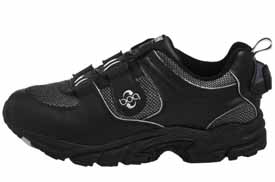 This is our Shoes For Diabetics Guide. I will note that choosing the right foot wear will depend a little on your individual circumstances. Some people need a little extra protection, while others need custom made shoes because of deformities or other injuries.
This is our Shoes For Diabetics Guide. I will note that choosing the right foot wear will depend a little on your individual circumstances. Some people need a little extra protection, while others need custom made shoes because of deformities or other injuries.
Initially, I want to cover why special consideration need to be made for your diabetic feet, then some common guidelines. Then, we can hit some of the more popular brands and situations that you may want to be aware.
The need for special diabetic shoes is because higher blood sugar can cause a variety of problems for your feet. Most notably, high glucose levels can lead to nerve damage. When your nerves get damaged, you have a much more difficult time feeling injuries and common foot problems, such as blisters, corns, ingrown toe nails, etc.
If you injure your foot or suffer some of these common foot ailments, then it can lead to infection. Also, foot injuries often do not heal as fast or as well in diabetics. Bottom line is that as a diabetic, foot injuries can lead to much more serious conditions than for people without diabetes.
Also, take a look at our guide to socks for diabetics. Obviously, shoes and socks go hand in hand!
TOP 7 FACTORS FOR CHOOSING DIABETES SHOES
- What Not To Wear: Don’t wear the following: sandals, flip-flops, high heals and pointed toe shoes. All of these shoes either leave your foot exposed or unnecessarily pinch or strain your feet. Also, do not walk around in bare feet.
- When to Buy: Okay, let’s just say it. Your feet swell as the day goes on. Thus, buy your shoes in the afternoon, to make sure they are big enough.
- Material: I looked at several other guides and the opinion was a little split. The best advice is to keep it soft. I also like the advice of keeping it breathable. You do not want the material to be hard and non-pliable. This can cause blisters. Also, you want your feet to breath so they do not get too wet. Wetness causes fungus, which causes infection.
- Length: This is an easy one. You should have 3/8 to 1/2 inch of space at the toe, so the toes are not pinched or tight.
- Width: Make sure the shoe is wide enough. Again, if it is too narrow, then your foot can get pinched, causing blisters.
- Seams: Feel inside the shoe for seams. Also, make sure you try and notice any seams when you try it on. Seams can rub on your foot when you where them, causing blisters.
- Overall Fit: While covered above, the big issue here is to make the shoe not too tight. BUT, you also do not want the shoe too loose. If your foot is sloshing around in a shoe that is too large, this can cause injuries a well. How does it fit in the heal, toe, instep, balls of feet, etc.? Take the extra time to think about each aspect of your foot when it is in your shoe.
WERE AND WHAT TO BUY
Okay, you get the guidelines above and now you want to go shopping. But, what are the best brands of shoes for diabetics? Do I have to buy specific diabetes shoes or can other shoes work as well? The simple answer is it depends on you and your specific foot.
Here are Popular Brands or Shoes for Diabetics:
New Balance: New Balance diabetic shoes (arguably the most popular diabetic shoe on the market today). These shoes are not exclusively diabetic, but they are often referred to as diabetic. I love New Balance shoes because they come in a huge variety of widths and most models are very comfortable.
Drew Shoes: Drew Shoes has an EXTENSIVE offering of shoes for diabetics, one of the best available. They have walking shoes, hiking shoes, and reasonably fashionable shoes.
Propet:
ECCO: These shoes are not branded as diabetic, but I find the shoes very comfortable.
Diabetic Slippers: Of all the different types of shoes, I will say for most people, you can find a good pair of regular slippers without having to pick exclusively from “diabetic” brands. However, here are some top diabetic slipper brands.
Bandwagon
Foamtreads
SOURCES:
American Orthopedic Foot and Ankle Society, Shoes and Orthodics for Diabetics
